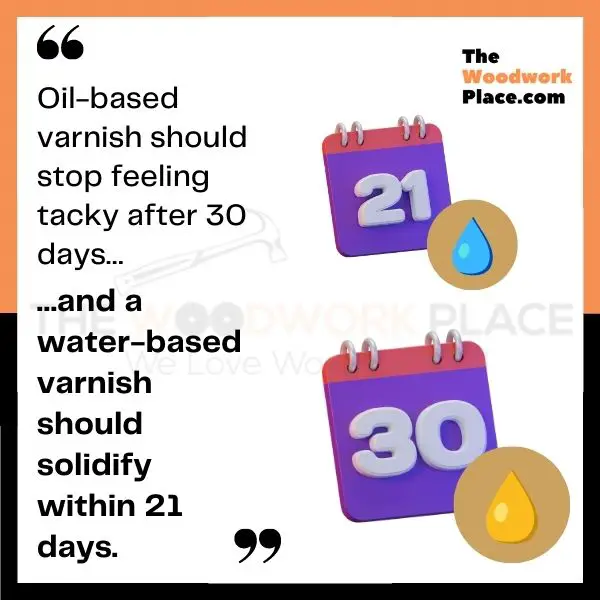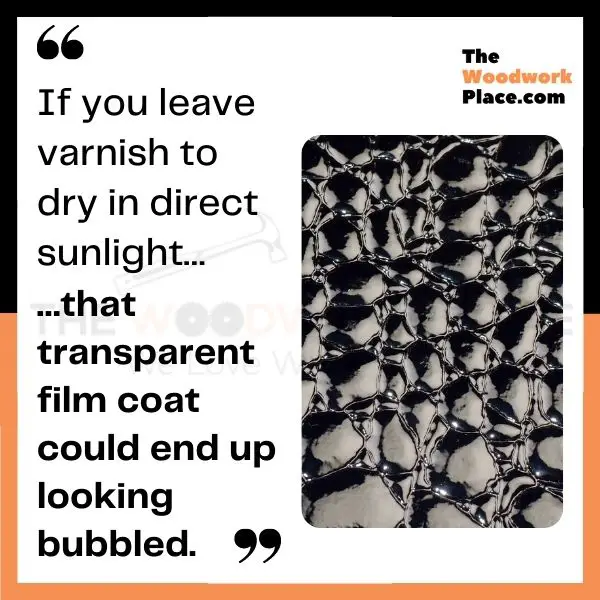Are you struggling to get that varnish coat to dry?
You’ve tried everything, turned up the heat, and opened a few windows. Heck, you’ve even tried spot-drying with a hair dryer. And yet that tacky varnish coat refuses to solidify.
Well, before you throw in the towel, (and sand off the varnish completely), give this article a quick read.
That’s because if you check out the post below, you will learn why a tacky varnish has more to do with ‘curing’ than drying. We also reveal why a hair dryer is not the best way to dry sticky varnish.
And discover why a little mineral spirit could go a long way towards fixing that tacky finish…

This post may contain affiliate links to products that we receive a commission for (at no additional cost to you). Learn more here.
Why Does Varnish Tend To Dry Faster Than Other Oil Finishes?
There are many different types of varnish, but the one generally used for wood finishing is oil-based varnish.
It’s made from a blend of drying oils, fast-drying solvents, and resins. As a result, varnish acts very much like a quick drying oil finish.
This means that not only will varnish dry, (evaporate from a liquid to a solid film), it will also go on to cure, (change from a solid film into a hard resin).
Related Post: Can You Really Varnish Over Linseed Oil? (Best Practice Revealed)
What Is The Difference Between Drying And Curing?
When it comes to varnish, the process of ‘drying’ refers to evaporation. Heat turns solvents into fumes, leaving behind a solid film.
It only takes varnish a few hours to dry. And a fast-drying varnish product can solidify in as little as 30 minutes.
However, the process of ‘curing’ is a chemical reaction, one in which varnish goes through polymerization. And this turns varnish into a final hard durable coat.
And the curing process takes much, much longer than just drying…
Related Post: Can You Use Food Safe Wood Varnish On A Butcher Block?
What Is A Typical Varnish Cure Time?
A water-based varnish can take around 2-3 weeks to cure all the way through. While an oil-based varnish takes a little longer, requiring 30 days or so to complete curing.

Why Is This Varnish Tacky Across The Surface?
A tacky varnish is basically one that still feels soft to the touch. It may be a dry film, but it’s anything but solid.
The real problem with a tacky varnish isn’t that varnish isn’t drying. The issue is that your varnish coat is struggling to cure.
Now, the drying and curing times listed on the side of that varnish product, depend on whether that varnish is drying in ideal conditions.
In the right environment, varnish will dry without much fuss. But if the temperature is too low, (or the humidity is too high), varnish won’t cure.
What Are The Ideal Drying Conditions For Varnish?
For an oil-based varnish, you need the room temperature to be between 40 °F to 90 °F. In addition to that, the room needs to be relatively free of humidity.
Humidity levels above 85% will make it next to impossible for varnish to cure (or even dry) at all. So, aim for a humidity range of between 40% to 50% or so.
What If The Temperature And Humidity Aren’t The Problem?
If varnish has been left to dry in fairly optimal conditions, then the next thing you need to check for is excess varnish.
You see, it is very easy to apply too much varnish per coat. Especially if you’ve put it on using a brush.
Varnish is already very thick to begin with. And, more often than not, varnish needs a thinning agent to dilute it a bit before application.
So, if too much varnish has been layered on, you need to try and remove the tacky excess. In short, you need to thin out the coat by doing the following:
1). Dampen a lint-free rag in mineral spirits or turpentine.
2). Run that rag over the tacky varnish surface.
You’re aiming to soften up the varnish with mineral spirits. At least enough so that you can scrape it off afterward. Don’t attempt to remove the varnish using that damp rag.
3). Once the varnish has softened enough, use a fresh clean lint-free rag to wipe off the excess.
This will leave behind a much thinner varnish film. And that thinned out varnish coat will dry and cure much faster.
This Varnish Is Still Sticky After A Week! Will Sticky Varnish Dry Eventually? Unless you know what’s preventing it from curing, a tacky sticky varnish isn’t going to dry anytime soon. If you leave tacky varnish as is, it could be months (or even longer) before it finally firms up.
Can You Try Drying Varnish In The Sun?
You could… varnish will certainly dry under sun rays. However, the way it will dry can create another problem altogether; bubbling.
And here’s why; blasting direct sunlight at varnish only serves to ‘cook’ varnish from the outside in.
Basically, the outermost part of that varnish coat will ‘flash’ dry and cure way too fast. But, all of the varnish just underneath it will continue to dry and cure at a slower pace.
This can create bubbling problems across the varnish coat.
That’s because the still curing varnish, (underneath the ‘cooked’ varnish), is still drying and releasing solvent fumes. This is referred to as ‘off-gassing’.
Those varnish off-gassing bubbles are essentially all trapped. And this is what creates bubbling across a varnished surface.
So, best practice is to let varnish dry at its own pace, in low-light conditions.
What About Drying Varnish With A Hair Dryer?
You shouldn’t use a hair dryer to dry varnish. At least not if you want a nice, even finish.
Blowing air around will kick up dust and grit. And those dust nibs and grit can end up landing on the varnish, only to get caught up in the finish as it dries.
Related Post: Are There Dust Nibs In Your Polyurethane Finish? (How To Fix It)

Why Is My Varnish Dry In Some Areas And Only Tacky In Certain Spots?
Sometimes, the problem may not be with getting the varnish coat itself to dry and cure. Sometimes, the problem lies beneath it.
When a varnish coat is only tacky in certain areas, (yet has cured through in other sections), then your problems go deeper. On these rare occasions, your problem is that natural wood surface wasn’t clean of a previous old wood finish.
This can tend to happen if you’re refinishing furniture. So, before you apply varnish, you need to make sure you’ve removed all of the previous finish first (particularly any wood wax finish).
Related Post: Can You Varnish Over Wax Finished Furniture?
If you don’t, (and you layer varnish over those ‘old finish’ spots), the varnish coat may never cure.
What Can You Do If The Wooden Surface Itself Is The Problem?
Only option in this extreme case is to strip the varnish coat off completely using mineral spirits.
You would then carefully clean the bare wooden surface underneath using mineral spirits again. Afterwards, you can then go on to reapply the varnish coat.
To Wrap Up, Here Are The 3 Main Takeaways…
1). Oil-based varnish should stop feeling tacky after 30 days. And a water-based varnish should solidify within 21 days.
2). If you leave varnish to dry in direct sunlight, that transparent film coat could end up looking bubbled.
3). Fix tacky varnish by thinning and smoothing it out using a mineral spirit dampened rag.
References:
Effect of wood moisture content on adhesion of varnish coatings – Academic Journals.org


